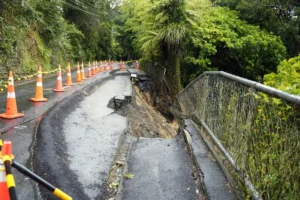
After Cyclone Gabrielle raced across the country’s north, causing widespread flooding and leaving tens of thousands of people without power, New Zealand declared a national state of emergency—the third time in its history.
According to local media reports, landslides had swept away homes, highways were under water, and people were trapped on their roofs amid increasing seas.
In certain places, mobile phone services were also unreliable.
“New Zealanders have had a big night around the nation, but especially in the upper North Island,” Many people have been uprooted, many homes are without power, and the country has sustained significant damage, the prime minister Chris Hipkins told reporters on Tuesday after the emergency was declared.
The cyclone is now located around 100 kilometers (60 miles) east of Auckland, close to the country’s North Island’s east coast, and it is anticipated to track about east-southeast, parallel to the shoreline.
As emergency services failed to keep up, emergency management minister Kieran McAnulty signed the declaration. The choice enables greater resources to be allocated to the six worst-hit areas.
He described it as a “extraordinary weather phenomenon” that was severely affecting much of the North Island. “Extensive floods, slips, damaged roads, and infrastructure affect all of us.”
More rain and strong gusts are anticipated, and as the storm advances, it’s anticipated that the upper South Island will also see severe weather.
The weather forecasts that had come in over night, according to McAnulty, were “very alarming.”
According to Hipkins, it was too early to estimate the number of injured or displaced persons. There have been no verified fatalities.
The national fire and emergency service said that a firefighter was missing after a house in West Auckland fell, while another had been rescued and was in critical condition at a hospital.
A ship from the New Zealand navy is en route to a yacht off the east coast that activated its emergency signal this morning.
Auckland, the largest city in New Zealand, has a population of about 1.6 million. Cleaning up after the area’s catastrophic flooding two weeks ago was already difficult.
When the COVID-19 pandemic struck in 2020 and the Christchurch earthquake in 2011 respectively, New Zealand previously proclaimed national emergencies.




